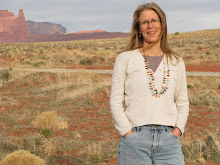It's been a crazy week of writing deadlines - I'm working on a feature article for
National Parks magazine on the history and future of cottonwood riparian forests, those oases of shade and water that green the arid West. Just as I was starting on the final push to finish the piece came an invitation to attend a gathering in honor of the Orion Society and
Orion Magazine hosted my friend
Bill deBuys (if you haven't read his
River of Traps, you're missing an incredible look at northern New Mexico). The gathering, sponsored by the non-profit organization
simpleChange, featured Chip Blake, head of the Orion Society and Orion Magazine, and Barry Lopez, one of my heroes in writing and life, and his partner Debra Gwartney, editor of
Home Ground, a thick volume that calls itself an encyclopedia of landscape terms but is really an extended essay of affection and attachment by some fine writers who throw their hearts and prose into defining the features characteristic of the landscapes we live on and love.
How could I turn down the chance to hang out with Barry, Debra, Chip, Bill, goddess of editing and publicity Nancy Fay, and 40 other interesting people? I couldn't, even though it meant an 8-hour round-trip drive in the middle of a crazy work week. Fortunately, Richard, my love and the carrier of my briefcase on trips such as this, offered to drive. We set out on a windy afternoon and tacked cross-gust up and over Poncha Pass and south down the long expanse of the San Luis Valley. When we dropped off the Taos Plateau into Ojo Caliente in northern New Mexico, the apricot trees were blooming in billowing clouds of white and pink around the adobe farmhouses. Spring!
Listening to Barry Lopez speak about the state of the world today was humbling, inspiring, and left me feeling hopeful for what each of us can do for this Earth that sustains us, and for each other: love.
He believes in the power of loving action, of people working in their own communities, the wisdom that is inherent in the land and each of us, and how real power comes from ordinary people cracking open our walls and being vulnerable and aware and active in the world. (He said it better, of course. My excuse for paraphrasing badly is that I'd worked all day and then had a four-hour-drive to get to the event in the first place. But it was worth it.) I'm still thinking about the conversations of that night, integrating what I heard and said and letting it all settle before I decide where to go with it.

One place I'll go is back to my kitchen garden, where I work with earth and sunlight and my partners, the plants and their partners in pollination, to grow a good portion of the food we eat. And that brings me to where I'll be this
Saturday, April 7th, between 1:30 & 3:00 p.m.:
Tattered Cover Bookstore in Highlands Ranch (9315 Dorchester Street, between Lucent Drive and Broadway in the Highlands Ranch Town Center) where I'm part of an "expert panel" of garden book writers including Angela Overy (Sex in the Garden) and Dave Wann (The Zen of Gardening in the High and Arid West) there to answer your questions about playing with plants in our challenging environment. The point is to sell books, of course, but I'd be happy to see any and all of you whether you buy books or not.
Speaking of gardening, the spinach and Mesclun lettuce mix I planted in my kitchen garden last fall survived the winter (under row covers and some serious snow) and are now happily producing early greens. The tomatoes and basil I seeds I started inside three weeks ago are growing apace; they're nearly ready to transplant to larger pots.
And we saw the first mountain bluebird today, blue as a chip of sky. Spring is here!









